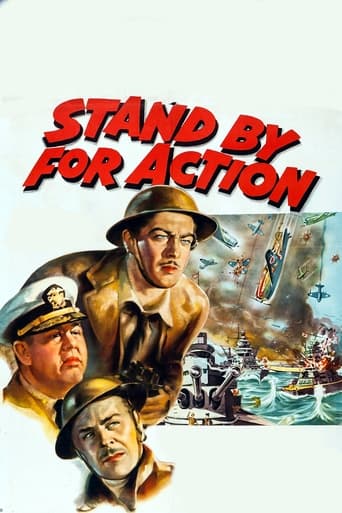

This film starts very strong with Robert Taylor playing a Ivy League-trained Reserve Navy Officer who so far during WWII has become accustomed to serving duty in an assignment on the fringe of the war as an Admiral's aide where he enjoys plenty of hobnobbing with females at Washington DC social events. His commitment is put to the test when his boss assigns him as Executive Officer of a rusty WWI Tin Can that he must now man and ready for deployment.Brian Donlevy is solid as always as the Tin Can's skipper and given our current Middle East military call-ups, the film points to some interesting issues regarding the Reservist Taylor serving on active duty in wartime. A film worth watching, but ultimately, however, it saps itself too deep in corny WWII patriotic sentimentality, thereby missing an opportunity to become one of the better war films.
... View MoreThe description of the movie was correct with one exception. The Japanese ship that was sunk by torpedoes was a Battleship, not a destroyer. While this may seem to be only a slight detail, it is most important in the significance of our hero saving the entire convoy from eminent destruction. This movie was typical of the war era movies in that heroic Americans always overcame overwhelming odds. A real moral builder. The movie was broadcast on TCM cable channel, on May 27th as part of its salute to Memorial Day. I was glad to Robert Taylor, who I met during World War II, in Dallas when he was in the Navy. He was in is Navy uniform and looked every bit the person he played in "Stand by for Action"
... View More"Stand By For Action" has a little bit of everything: tennis, babies, head injuries, sea battles, propaganda, multiple births, and Charles Laughton milking every scene like only he could do. The film tries so hard to squeeze in so much that I was expecting Brian Donlevy to give Robert Taylor advice on how to keep his mustache properly trimmed, as well as the wisdom he gives him on commanding a ship. "Stand By For Action" is unfocused and this is why it feels like it drifts to a climax rather than steams ahead. However unrealistic the final battle scene might be, I did find myself caught up in it. It maybe helped that they had Laughton act as narrator to make some sense of what the Warren was up to.
... View MoreThe movie is divided into three parts, like Gaul. Part I: Character. Charles Laughton as the crusty old admiral (is there any other kind?) longs to get back to sea and join the war in 1943. Laughton has an efficient but cocky and somewhat spoiled aide in Robert Taylor -- a Harvard man. Brian Donleavy is a former enlisted man who has worked his way up to Lieutenant Commander and Laughton makes him skipper of a refurbished old destroyer, the USS Warren left over from WWI. Figuring that his aide needs a bit of seasoning to make a good officer, Laughton assigns him to the Warren as Executive Officer. Taylor makes a decent exec but misses no opportunity to twit the captain.Part II: "Comedy." There is no romantic interest for Taylor, so the film introduces sentiment and comedy by having the Warren pick up a lifeboat filled with two women and a dozen babies. The crew goes nuts over the presence of the women and babies, especially when it turns out that BOTH of the women are pregnant and must give birth in sequence.Part III: Action. Because of Taylor's having made a mistake in judgment, the Warren shows up an hour late before taking its position as part of the destroyer screen for a convoy. A Japanese battleship shows up and wounds the convoy's flagship. Donleavy decides on a courageous and almost certainly suicidal manouever to save the convoy, but he is knocked unconscious before he finishes. Taylor takes over command, zips the Warren back and forth through its own smoke screen, and blows the battleship (a "pagoda-masted buzzard") out of the water.I wish I could say I liked it because I'm ordinarily attracted to these inexpensive and propagandistic movies made during the war, some of them well executed within their limitations. This isn't one of them. It's easy going enough, no more intense than a war-time comic book, but it's too long to hold one's interest.The comedy episode is really really dated. Maybe we've seen too many movies in which women (with or without kids) are reluctantly taken aboard a warship -- "Operation Pacific", "Operation Petticoat," "Hell or High Water," and the couldn't-be-better-titled "The Baby and the Battleship." Whatever the reason, my heart sank when the lifeboat full of babies showed up because I knew what was coming. What I didn't know is that it would take so agonizingly long to get through it. The officers' eyes pop. The men assigned to care for the babies are plug uglies. And then the deliveries of the new babies. Eyes pop again. "She can't have a baby -- that's against regulations!" The pharmacist's mate is scared to death. Everybody is scared to death. The crew paces back and forth, smoking nervously, while the baby is delivered. ("A boy?") Then the second lady comes to term and we go through the whole routine once more. It's like being on the Long Island Expressway on a Sunday night, with the cars rolling along at ten or sometimes five miles an hour, sometimes stopping completely.I won't go on. It's not a hateful movie. I just wish it had been better so that I could recommend watching it but my muse is screaming in my ear.
... View More